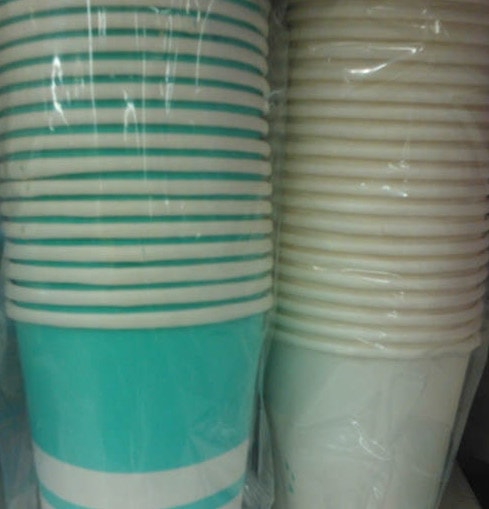Poisoning due to using convenient paper cups
No origin, no label,... paper cups floating on the market are still selling quite well. According to experts, even when using paper cups with guaranteed quality, consumers can still easily be "poisoned"...
Risk of chemical contamination
Walking around markets and supermarkets, paper cups, bowls, and plates are sold quite commonly with a variety of designs and colors, chosen by many consumers due to their convenience and affordable prices.
According to a salesman at a department store on Chua Boc Street (Hanoi), disposable paper cups and plates are popular because of their convenience. There are two types of paper cups: cold and hot. Cold cups are used to hold cold drinks, so they are usually coated with a layer of wax inside to keep the paper from getting damp and crumbling when exposed to water.

Hot cups are designed to hold hot drinks such as coffee, tea or chocolate. Hot cups help keep drinks warm. It is worth mentioning that the indispensable ingredient to create these products is the plastic that has the effect of waterproofing the outside of the cup. If not handled properly, this plastic layer can melt when using the cup at high temperatures.
However, on the market today there are many types of plastic cups, paper cups floating around, with unknown origin and labels, used by grocery stores, cheap rice shops, vermicelli shops, etc. to contain food, especially soup, hot coffee...
Dr. Nguyen Gia Dien (Institute of Chemistry) said that the use of paper cups in developed countries has become a consumer style for decades. Paper cups can be used for both hot and cold water. To do so, the materials used to make cups must meet strict standards on the quality of paper, plastic, additives, etc. If the production process as well as the input materials are not guaranteed, the convenience is insignificant compared to the negative effects on health.
The waterproof coating is not good and can only withstand a certain temperature range. If you use water that is too hot, the polymer layer will be released and mix with food and drink, entering the human body. Therefore, when using disposable plastic cups or paper cups, you should only use reputable brands and absolutely avoid floating, unlabeled products.
Consumers should be careful when using paper cups.
According to engineers from the Institute of Chemistry (under the Vietnam Academy of Science and Technology), to ensure safety for users, in principle, paper cup manufacturers will use PE plastic, but in Vietnam, the type of plastic that many businesses use is PVC. If the processing process does not ensure quality, when used, the glue, plastic and paper pulp will peel off and mix with food and drinks, causing food safety problems.
As for cups made from paper mixed with waterproof additives, glue containing melamine, phenol... is used, which is a strong waterproof additive, can prevent water. Paper pulp will not dissolve in temperatures from 40-70 degrees Celsius.
However, if boiling water at 100 degrees Celsius is poured into cups and bowls, the plastic will melt into drinks and food. In addition, some people reuse paper cups and plates, leading to the risk of chemical contamination.
Disposable paper cups look very hygienic and convenient, but it is difficult to know whether they meet the standards or not. Usually, the pure white cups may have been soaked in bleach, a potential carcinogen. As for soft cups (deformed after pouring water) or cups with a lot of white dust inside… are definitely not products that should be used.
In addition, paper cups left for a long time will be at risk of mold, creating favorable conditions for germs and disease-causing bacteria to develop. Therefore, when using dishes and paper cups, consumers should be careful to choose products that have been tested for quality and follow the manufacturer's instructions for use...
Counterfeit goods "reign"
With the price of 10,000-15,000 VND/20 pieces, the paper cups displayed in Dong Xuan market (Hanoi) come in many colors but all follow the criteria: floating goods, no origin. The sellers always claim that the products are domestically produced, but when looking at the bottom of some cups, the words "made in China" are printed very faintly.
According to the sellers here, paper cups are currently consumed a lot by sidewalk cafes and restaurants. “Many people also buy them to use when traveling. Because they are disposable, most buyers choose cheap products with nice designs,” said a seller.
However, the problem related to health is not only in the production facilities but also in the consumers themselves. Disposable cups and plates still look very new, so many people put them away to use a few more times, leading to the risk of chemical contamination of the raw materials of paper cups and plates. Because of repeated use, the pulp and glue, plastic, and chemicals will mix into food and drinks. Paper cups that are left for a long time and become moldy are also a breeding ground for germs and bacteria that cause disease.
Not only that, because of the desire for cheapness and the use of counterfeit goods, manufacturers often "forget" to write instructions for use. Therefore, many consumers "carelessly" use paper cups that are only used for drinking cold water to hold hot water, make coffee, or hold hot soup...
Therefore, we need to note that with paper cups, thin plastic cups, especially those without labels, they should only be used to hold cold water, not to hold hot water or to make tea or coffee that requires hot water. Instead, we can use ceramic cups or glass cups, which are both more durable and safer.
According to Vietnam.net. DP






